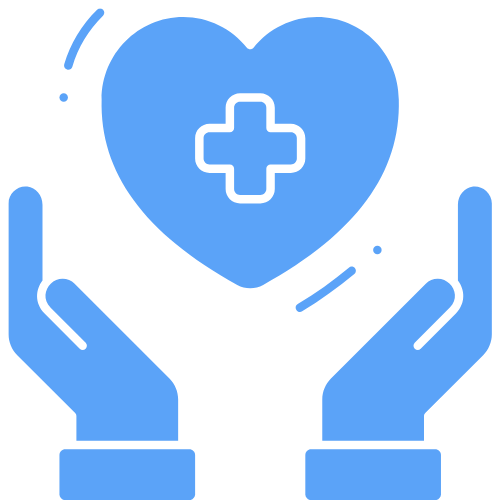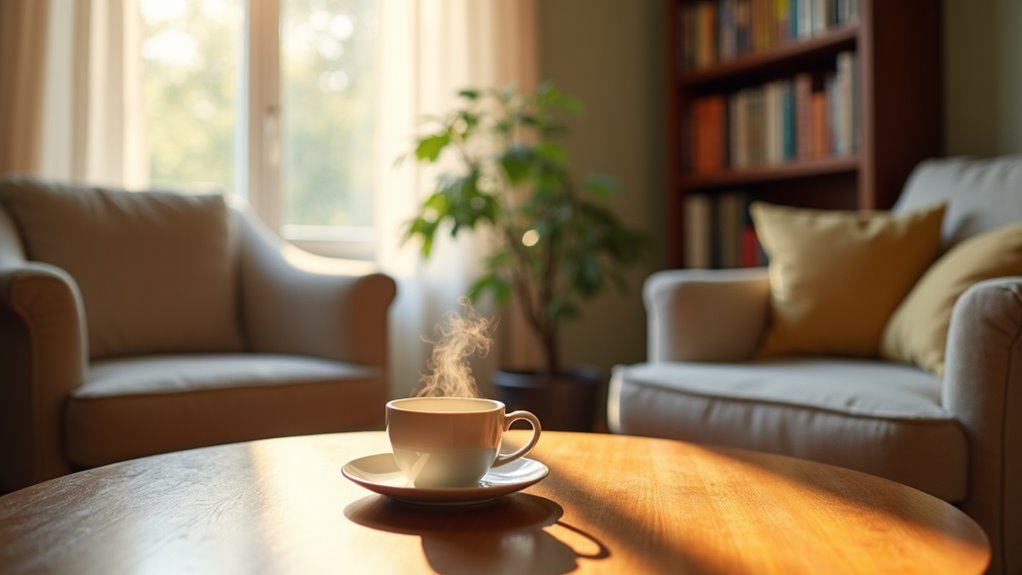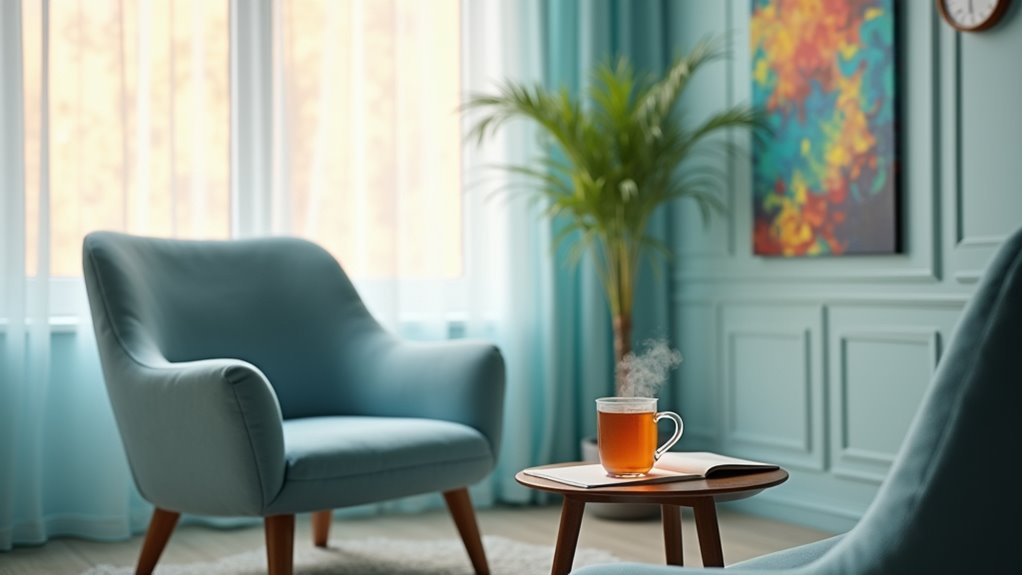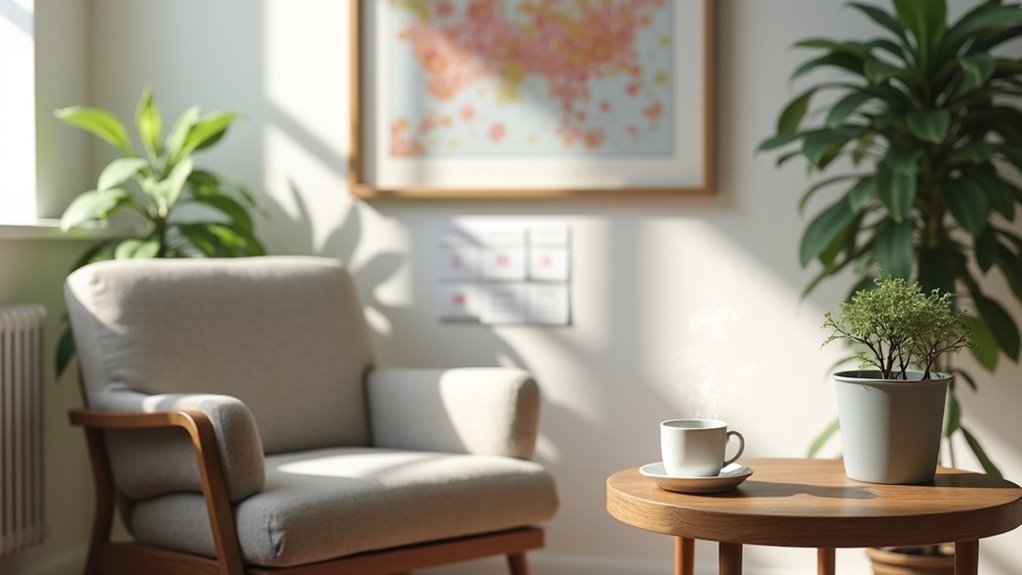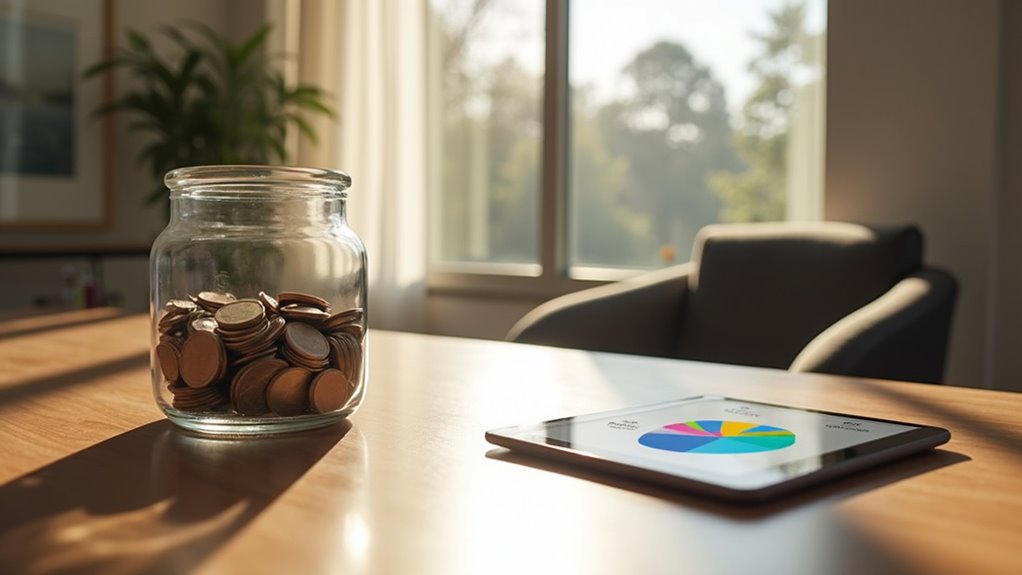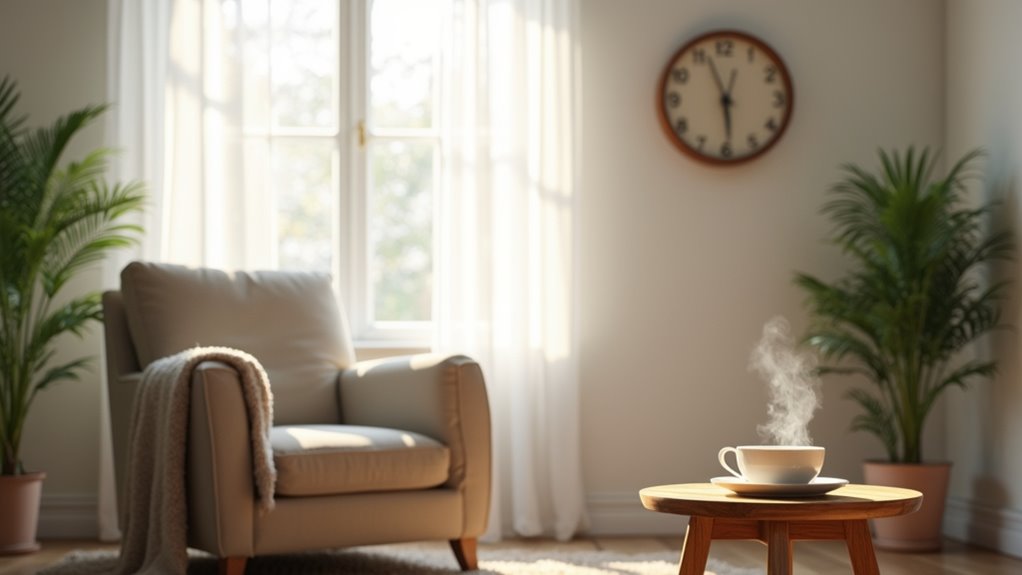Men’s Mental Health Day occurs during June (Men’s Mental Health Month) and focuses on “Turn Awareness into Action” for 2025. You’ll find major events including the Men’s Mental Health Conference Weekend (May 16-17) and Mental Health Action Day (May 15). With nearly 80% of suicides committed by men and only 40% seeking help, recognizing warning signs like sleep disturbances and irritability is essential. Investigate how community support and redefining masculinity can transform men’s approach to emotional well-being.
The Alarming Statistics Behind Men’s Mental Health

Nearly four out of five suicides in the United States are committed by men, highlighting a profound gender disparity in mental health outcomes.
Men die by suicide at rates four times higher than women, with middle-aged and older men facing the greatest risk.
Despite 77% of men reporting symptoms of anxiety, stress, or depression, only 40% with diagnosed mental illness receive care.
This treatment gap stems from multiple barriers 29% feel “too embarrassed” to discuss mental health issues, while 22% express discomfort speaking with healthcare providers. Men face harmful toxic masculinity that reinforces the idea that seeking help is a weakness.
Men’s vulnerability often remains hidden behind societal expectations of masculinity. Many men struggle with depression manifesting as anger or irritability rather than traditional sadness, making diagnosis more challenging.
Mental health awareness efforts must address that 40% of men won’t discuss their mental health with anyone, including professionals, despite 35% believing they’ve experienced diagnosable conditions during their lifetime.
Health providers frequently mislabel or underestimate men’s mental health needs due to gender biases in assessment and diagnosis.
Breaking the Silence: Common Mental Health Issues Affecting Men
While society often paints mental health struggles as chiefly feminine concerns, the data reveals a different reality for men across America.
Depression affects 9% of men annually, while anxiety and substance abuse disorders each impact 10%. These conditions frequently manifest through anger, risk-taking behaviors, and physical symptoms rather than conventional presentations.
Men face unique challenges that complicate their mental health path. Societal expectations of stoicism create barriers to emotional vulnerability, often pushing men away from unhealthy coping mechanisms. Work-related stress is a significant contributor, with approximately 20% of men experiencing high levels of work-related stress that can lead to burnout. Men are often less likely to receive proper diagnosis or treatment due to their reluctance to discuss emotional struggles.
Society’s demand for male stoicism silently pushes men from healthy expression toward destructive alternatives.
This reluctance to seek help contributes to alarming outcomes despite lower diagnosis rates, men have higher suicide rates. Nearly 75% of all annual suicide deaths worldwide are men, highlighting a crisis that demands immediate intervention.
Less recognized conditions also disproportionately affect men, including eating disorders (10%), antisocial personality disorder (3%), and narcissistic personality disorder (60% of diagnoses).
Overcoming Barriers to Seeking Professional Help

Confronting internalized stigmas about therapy requires you to recognize how traditional masculine ideals of self-reliance can impede necessary help-seeking behaviors.
True strength emerges through vulnerability and the willingness to address psychological challenges proactively, rather than through silent endurance or maladaptive coping mechanisms. Many men struggle to recognize symptoms because depression often manifests as anger or irritability rather than conventional sadness in male patients. Black men face additional barriers shaped by intersecting cultural expectations and systemic factors that compound mental health challenges.
Action-oriented approaches like coaching methods can offer practical solutions that align better with how many men prefer to address their challenges. Accessible support options, including telehealth services, male-specific programs, and sliding-scale therapy, can effectively reduce practical barriers that often prevent men from engaging with mental health professionals.
Recognizing Harmful Stigmas
Despite significant advancements in mental health awareness, men continue to face substantial barriers when seeking professional help. The pervasive influence of toxic masculinity creates an environment where emotional vulnerability is viewed as weakness rather than strength.
These harmful stigmas manifest through societal expectations that men should remain stoic and self-reliant regardless of their psychological distress. You may find yourself caught between acknowledging your needs and conforming to traditional masculine ideals that discourage help-seeking behaviors. The data showing that fewer than half of men experiencing depression disclose their symptoms or seek treatment highlights the severity of this problem.
Research demonstrates that these internalized stigmas often lead to maladaptive coping strategies, including substance abuse and social withdrawal. The 2021 statistics reveal a troubling reality where the male suicide rate was nearly four times higher than that of females. The consequences can be severe, with men experiencing higher rates of undiagnosed depression and suicidal ideation.
Recognizing these harmful narratives is the initial critical step in dismantling the psychological barriers that prevent accessing essential mental health resources.
Redefining Masculine Strength
True masculine strength lies in the courage to acknowledge vulnerabilities and seek appropriate support when needed. Research shows that 6 million U.S. men battle depression annually, yet traditional masculine norms markedly impede help-seeking behaviors.
You may recognize depression differently than clinical descriptions suggest manifesting as irritability, anger, or risk-taking rather than sadness. This normative male alexithymia (difficulty expressing emotions) creates barriers to emotional resilience. Men who conform to these traditional masculine ideals often express negative attitudes toward mental health services.
The concept of “John Henryism,” particularly affecting Black men, promotes silently enduring stress rather than seeking help. By reframing vulnerability as strength, you can overcome these internalized barriers.
Healthcare providers increasingly recognize these gender-specific symptoms, allowing for more effective treatment approaches that honor your experience while promoting genuine healing and emotional well-being. Support groups offer safe spaces where men can experience emotional wellness while maintaining their sense of masculine identity.
Accessible Support Systems
Steering the path to professional mental health support requires overcoming substantial barriers that many men face daily. Research demonstrates that creating male-friendly services greatly improves help-seeking behaviors when designed with gender-specific considerations. With only 36% of psychological therapy patients being men, there is a clear need for specialized approaches to encourage male participation.
- Community outreach programs in familiar settings like barbershops and places of worship reduce stigma by normalizing mental health conversations.
- Digital platforms offering telehealth options provide anonymous access points, particularly beneficial for men concerned about public perception.
- Culturally sensitive resources address specific challenges faced by Black men and ethnic minorities experiencing “John Henryism.”
- Men-centered services that recognize male-specific depression symptoms (anger, aggression, substance abuse) improve diagnosis rates.
When seeking help, look for professionals trained in male-specific symptom recognition and consider reframing mental health as “mental fitness” to align with traditional masculine values.
Recognizing Warning Signs and Symptoms in Men

Mental health challenges rarely announce themselves with clear, unambiguous signals in men. Instead, warning signs often manifest through physical complaints, behavioral changes, and performance issues that may not immediately suggest mental health concerns.
You might notice sleep disturbances, unexplained pain, or persistent fatigue. Watch for emotional indicators like irritability, flat affect, or uncharacteristic aggression. Men often experience low energy levels and loss of appetite as physical manifestations of mental health conditions.
Behavioral changes such as increased substance use, withdrawal from relationships, or engaging in high-risk activities warrant attention.
At work, decreased productivity, decision-making difficulties, or excessive work escapism can signal underlying problems. Many men use over-engagement in work as a way to cope with and mask their emotional distress.
Likewise, relationship conflicts, social isolation, and diminished interest in previously enjoyed activities often reflect deteriorating mental health.
Recognizing these warning signs early enables timely intervention, potentially preventing more serious mental health crises.
Key Awareness Events and Initiatives for 2025
Key awareness events in 2025 provide multiple opportunities for you to engage with men’s mental health initiatives.
Men’s Mental Health Month in June features the actionable theme “Turn Awareness into Action,” while November offers both International Men’s Day and Men’s Health Month (“Movember”) focusing on positive role models and targeted interventions.
Specifically, International Men’s Day on November 19, 2025 will create a platform for advancing discussions about men’s mental health and challenging harmful stereotypes.
Mental Health Awareness Week (May 12-18) and Mental Health Action Day (May 15) present extra platforms for workplace and community-based support through structured programs and evidence-based resources. The suicide crisis facing men under 50 represents a critical focus area, with suicide being the leading cause of death in this demographic. The 2025 theme of “community” emphasizes the importance of social connections in supporting men’s psychological wellbeing.
Flagship Calendar Events
As 2025 approaches, the terrain of men’s mental health awareness features several strategically positioned events that provide extensive support and educational opportunities.
You’ll find flagship event highlights spanning from April through May, creating a strategic sequence of engagement options.
- Men’s Mental Health Conference Weekend (May 16-17, Bowie, MD) offers extensive conference networking through mixers, sessions, and a gala.
- Bridge Builders Men’s Mental Health Conference (April 4-5, Salisbury, NC) addresses cultural barriers with no-cost attendance.
- Mental Health Action Day (May 15) implements the “Check In With A.S.K.” approach for relationship strengthening.
- Workplace Mental Health Action Summit (May 1) delivers virtual access to leadership strategies for organizational resilience.
These calibrated events collectively address personal, professional, and community aspects of men’s wellness. Organizers can access the Planning Guide to create impactful initiatives during Mental Health Month 2025.
Grassroots Campaign Opportunities
Emerging across multiple sectors, grassroots men’s mental health initiatives for 2025 demonstrate unprecedented reach and groundbreaking engagement strategies.
Community-based programs like barbershop interventions and Men’s Sheds provide accessible entry points, while faith communities launch support groups in over 1,000 congregations nationwide.
Digital grassroots strategies include the viral #RealMenTalk campaign and AI chatbots offering anonymous crisis support.
The 40% year-over-year growth in men’s mental health podcasts reflects significant demand for these resources.
Workplace community engagement continues evolving with “Hard Hats & Healthy Minds” in construction and “Emotional Fitness” sessions becoming standardized across industries.
Educational institutions further support this movement through dedicated curricula and symposiums, while creative arts initiatives particularly the “Open Mind” celebrity video series effectively normalize help-seeking behaviors among men.
Essential Resources and Support Systems for Men
Accessing appropriate mental health resources remains a critical component for men seeking support for psychological well-being.
Professional services, peer support groups, and digital platforms comprise the foundation of extensive mental wellness resources and support networks available to you.
- Organizations like NIMH, MHA, and NAMI offer specialized programs addressing men’s unique mental health challenges.
- Online platforms including ManTherapy.org and HeadsUpGuys provide customized resources for managing depression and anxiety.
- Professional services range from male-focused therapy groups to telehealth options for those in remote locations.
- Community-based support through men’s sheds, sports clubs, and faith-based organizations creates valuable social connections.
You’ll find both clinical interventions and peer support accessible through EAPs, sliding-scale services, and virtual communities designed specifically for men’s mental health needs.
Frequently Asked Questions
How Can I Approach a Male Friend Struggling With Mental Health?
Approach your friend during a relaxed moment in a private setting. Use supportive conversation starters like “I’ve noticed you seem different lately how are you really doing?” and ask twice if needed.
Employ active listening techniques by maintaining eye contact and validating his feelings without judgment. Share your own experiences to normalize the conversation.
Offer specific support rather than vague phrases, and suggest professional resources when appropriate.
Keep in mind that consistency in your support matters most.
Does Insurance Typically Cover Men’s Mental Health Treatment?
Yes, most insurance policies typically cover men’s mental health treatment. Federal law requires parity between mental health and medical benefits, ensuring extensive coverage for different treatment options including therapy, medication management, and substance use programs.
You’ll find coverage through employer-sponsored plans, ACA marketplace insurance, Medicare, and Medicaid. However, coverage specifics differ by plan, and you should verify network providers and potential out-of-pocket costs with your insurance company before beginning treatment.
What Self-Care Practices Are Most Effective for Men’s Mental Wellness?
The most effective self-care practices for men’s mental wellness combine physical and psychological approaches.
You’ll benefit from regular exercise, which releases stress-reducing endorphins, alongside mindful meditation that improves focus and reduces anxiety in just minutes daily.
Journaling benefits include improved self-awareness and emotional processing.
Quality sleep (7-9 hours) greatly impacts cognitive function, while maintaining social connections prevents isolation.
Therapy provides professional guidance when needed, complementing these evidence-based self-care strategies for ideal mental health outcomes.
How Do Different Cultures View Men’s Mental Health Differently?
Cultural perspectives on men’s mental health vary greatly worldwide.
You’ll notice Western societies often perpetuate cultural stigma through expectations of stoicism, while Asian cultures frequently view vulnerability as shameful.
African and African-American communities may emphasize spiritual solutions over clinical treatment, and Indigenous approaches integrate holistic healing traditions.
These differences stem from deeply embedded gender norms that define acceptable emotional expression.
Understanding these cultural variations is essential for developing effective, culturally-competent mental health interventions for men across diverse populations.
Can Exercise Replace Therapy for Managing Men’s Mental Health Issues?
Exercise can’t completely replace therapy for managing mental health issues.
While exercise benefits include neurobiological improvements, reduced inflammation, and similar effectiveness to pharmacotherapy for mild-to-moderate symptoms, it works best as a complementary approach.
You’ll experience best results when combining physical activity with professional mental health support.
Consider exercise as one of several therapy alternatives within a thorough treatment plan, especially since severe conditions require specialized psychological interventions that exercise alone can’t address.
